Case Study: Infection Control Strategies for MRSA Wound Infection
VerifiedAdded on 2023/06/12
|10
|3440
|104
Case Study
AI Summary
This case study examines the case of a 78-year-old patient, Jenkins, with a history of wound sepsis and recent readmissions to the hospital. The current admission reveals a wound infection caused by Methicillin-resistant Staphylococcus aureus (MRSA). The study reviews the prevalence and risk factors of MRSA, highlighting its impact in healthcare settings and the community. It emphasizes the importance of hand hygiene, standard precautions like gloving and gowning, and transmission-based precautions such as patient placement and equipment management. The roles of community care nurses and occupational therapists in patient care are also discussed, focusing on wound dressing, antibiotic administration, and improving the patient's quality of life. The case underscores the need for comprehensive infection control strategies to manage MRSA and prevent its spread.
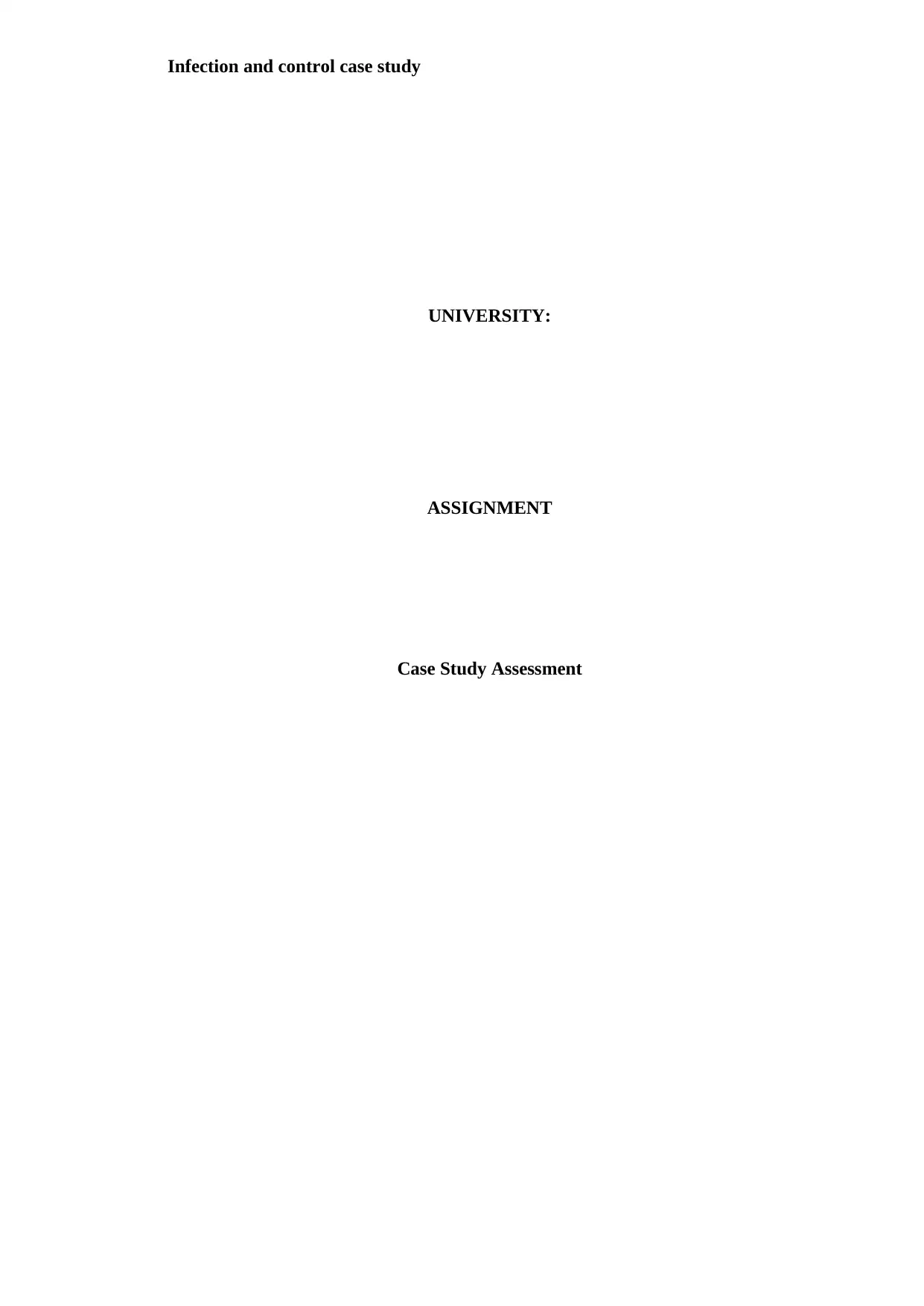
Infection and control case study
UNIVERSITY:
ASSIGNMENT
Case Study Assessment
UNIVERSITY:
ASSIGNMENT
Case Study Assessment
Paraphrase This Document
Need a fresh take? Get an instant paraphrase of this document with our AI Paraphraser
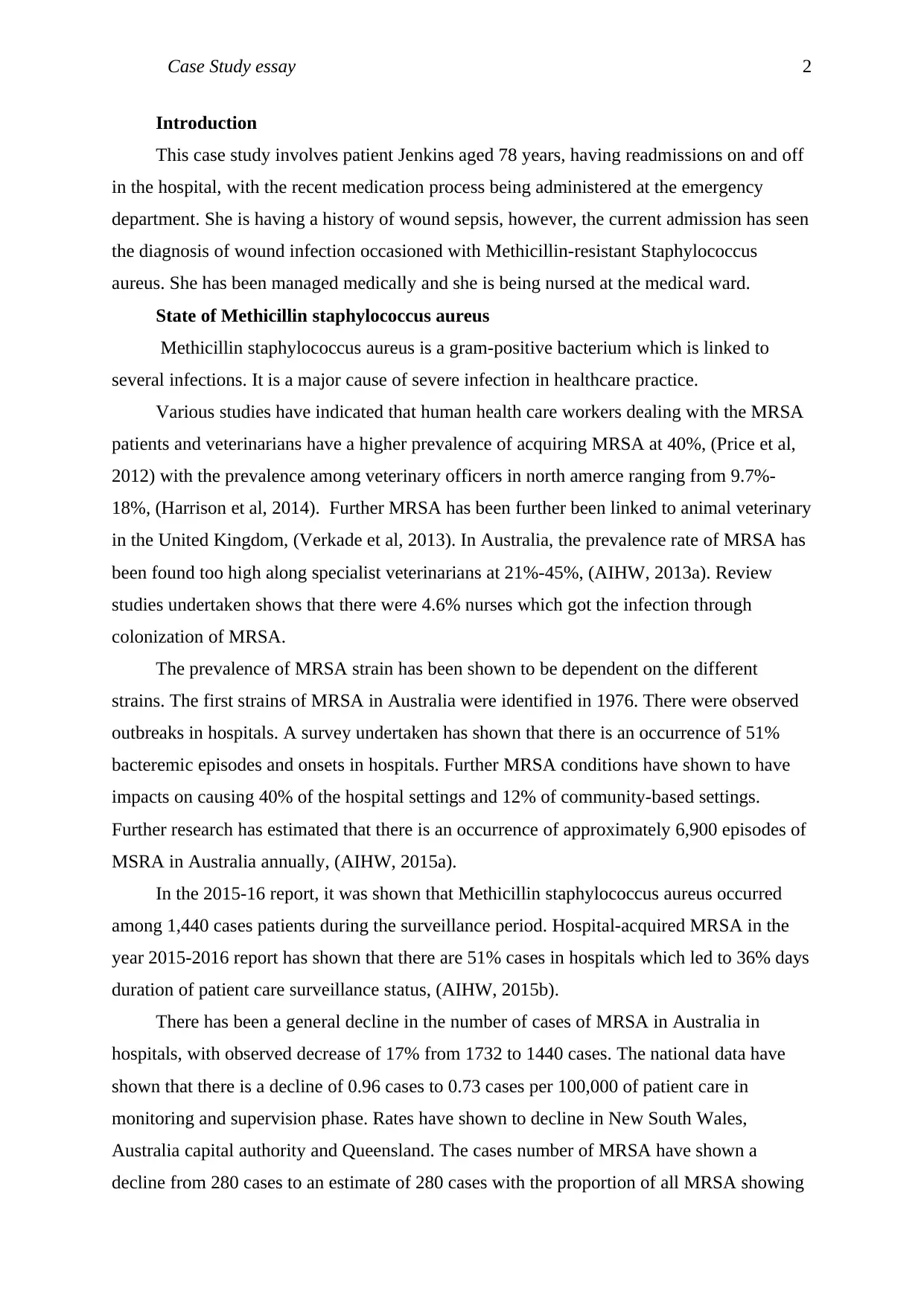
Case Study essay 2
Introduction
This case study involves patient Jenkins aged 78 years, having readmissions on and off
in the hospital, with the recent medication process being administered at the emergency
department. She is having a history of wound sepsis, however, the current admission has seen
the diagnosis of wound infection occasioned with Methicillin-resistant Staphylococcus
aureus. She has been managed medically and she is being nursed at the medical ward.
State of Methicillin staphylococcus aureus
Methicillin staphylococcus aureus is a gram-positive bacterium which is linked to
several infections. It is a major cause of severe infection in healthcare practice.
Various studies have indicated that human health care workers dealing with the MRSA
patients and veterinarians have a higher prevalence of acquiring MRSA at 40%, (Price et al,
2012) with the prevalence among veterinary officers in north amerce ranging from 9.7%-
18%, (Harrison et al, 2014). Further MRSA has been further been linked to animal veterinary
in the United Kingdom, (Verkade et al, 2013). In Australia, the prevalence rate of MRSA has
been found too high along specialist veterinarians at 21%-45%, (AIHW, 2013a). Review
studies undertaken shows that there were 4.6% nurses which got the infection through
colonization of MRSA.
The prevalence of MRSA strain has been shown to be dependent on the different
strains. The first strains of MRSA in Australia were identified in 1976. There were observed
outbreaks in hospitals. A survey undertaken has shown that there is an occurrence of 51%
bacteremic episodes and onsets in hospitals. Further MRSA conditions have shown to have
impacts on causing 40% of the hospital settings and 12% of community-based settings.
Further research has estimated that there is an occurrence of approximately 6,900 episodes of
MSRA in Australia annually, (AIHW, 2015a).
In the 2015-16 report, it was shown that Methicillin staphylococcus aureus occurred
among 1,440 cases patients during the surveillance period. Hospital-acquired MRSA in the
year 2015-2016 report has shown that there are 51% cases in hospitals which led to 36% days
duration of patient care surveillance status, (AIHW, 2015b).
There has been a general decline in the number of cases of MRSA in Australia in
hospitals, with observed decrease of 17% from 1732 to 1440 cases. The national data have
shown that there is a decline of 0.96 cases to 0.73 cases per 100,000 of patient care in
monitoring and supervision phase. Rates have shown to decline in New South Wales,
Australia capital authority and Queensland. The cases number of MRSA have shown a
decline from 280 cases to an estimate of 280 cases with the proportion of all MRSA showing
Introduction
This case study involves patient Jenkins aged 78 years, having readmissions on and off
in the hospital, with the recent medication process being administered at the emergency
department. She is having a history of wound sepsis, however, the current admission has seen
the diagnosis of wound infection occasioned with Methicillin-resistant Staphylococcus
aureus. She has been managed medically and she is being nursed at the medical ward.
State of Methicillin staphylococcus aureus
Methicillin staphylococcus aureus is a gram-positive bacterium which is linked to
several infections. It is a major cause of severe infection in healthcare practice.
Various studies have indicated that human health care workers dealing with the MRSA
patients and veterinarians have a higher prevalence of acquiring MRSA at 40%, (Price et al,
2012) with the prevalence among veterinary officers in north amerce ranging from 9.7%-
18%, (Harrison et al, 2014). Further MRSA has been further been linked to animal veterinary
in the United Kingdom, (Verkade et al, 2013). In Australia, the prevalence rate of MRSA has
been found too high along specialist veterinarians at 21%-45%, (AIHW, 2013a). Review
studies undertaken shows that there were 4.6% nurses which got the infection through
colonization of MRSA.
The prevalence of MRSA strain has been shown to be dependent on the different
strains. The first strains of MRSA in Australia were identified in 1976. There were observed
outbreaks in hospitals. A survey undertaken has shown that there is an occurrence of 51%
bacteremic episodes and onsets in hospitals. Further MRSA conditions have shown to have
impacts on causing 40% of the hospital settings and 12% of community-based settings.
Further research has estimated that there is an occurrence of approximately 6,900 episodes of
MSRA in Australia annually, (AIHW, 2015a).
In the 2015-16 report, it was shown that Methicillin staphylococcus aureus occurred
among 1,440 cases patients during the surveillance period. Hospital-acquired MRSA in the
year 2015-2016 report has shown that there are 51% cases in hospitals which led to 36% days
duration of patient care surveillance status, (AIHW, 2015b).
There has been a general decline in the number of cases of MRSA in Australia in
hospitals, with observed decrease of 17% from 1732 to 1440 cases. The national data have
shown that there is a decline of 0.96 cases to 0.73 cases per 100,000 of patient care in
monitoring and supervision phase. Rates have shown to decline in New South Wales,
Australia capital authority and Queensland. The cases number of MRSA have shown a
decline from 280 cases to an estimate of 280 cases with the proportion of all MRSA showing
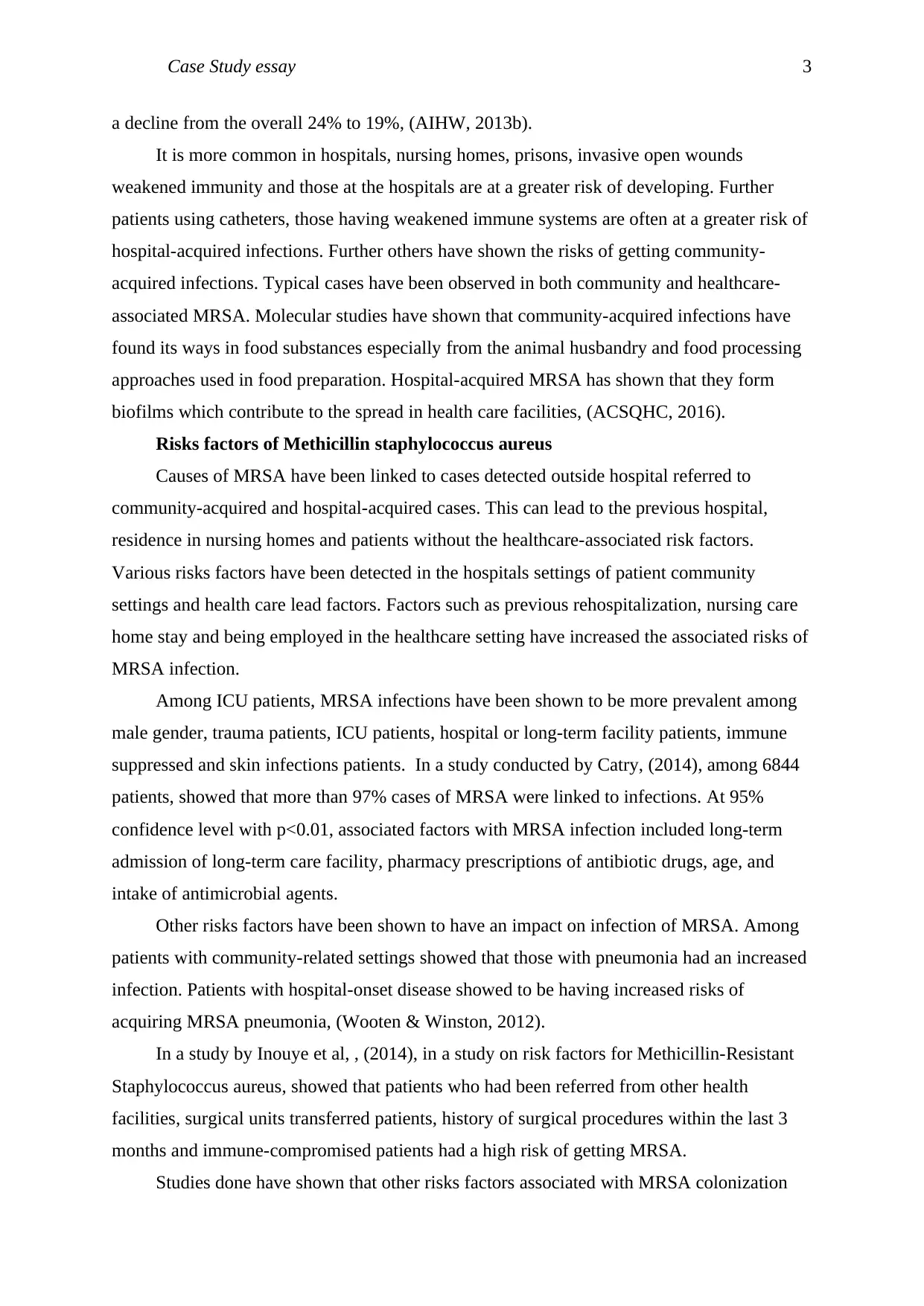
Case Study essay 3
a decline from the overall 24% to 19%, (AIHW, 2013b).
It is more common in hospitals, nursing homes, prisons, invasive open wounds
weakened immunity and those at the hospitals are at a greater risk of developing. Further
patients using catheters, those having weakened immune systems are often at a greater risk of
hospital-acquired infections. Further others have shown the risks of getting community-
acquired infections. Typical cases have been observed in both community and healthcare-
associated MRSA. Molecular studies have shown that community-acquired infections have
found its ways in food substances especially from the animal husbandry and food processing
approaches used in food preparation. Hospital-acquired MRSA has shown that they form
biofilms which contribute to the spread in health care facilities, (ACSQHC, 2016).
Risks factors of Methicillin staphylococcus aureus
Causes of MRSA have been linked to cases detected outside hospital referred to
community-acquired and hospital-acquired cases. This can lead to the previous hospital,
residence in nursing homes and patients without the healthcare-associated risk factors.
Various risks factors have been detected in the hospitals settings of patient community
settings and health care lead factors. Factors such as previous rehospitalization, nursing care
home stay and being employed in the healthcare setting have increased the associated risks of
MRSA infection.
Among ICU patients, MRSA infections have been shown to be more prevalent among
male gender, trauma patients, ICU patients, hospital or long-term facility patients, immune
suppressed and skin infections patients. In a study conducted by Catry, (2014), among 6844
patients, showed that more than 97% cases of MRSA were linked to infections. At 95%
confidence level with p<0.01, associated factors with MRSA infection included long-term
admission of long-term care facility, pharmacy prescriptions of antibiotic drugs, age, and
intake of antimicrobial agents.
Other risks factors have been shown to have an impact on infection of MRSA. Among
patients with community-related settings showed that those with pneumonia had an increased
infection. Patients with hospital-onset disease showed to be having increased risks of
acquiring MRSA pneumonia, (Wooten & Winston, 2012).
In a study by Inouye et al, , (2014), in a study on risk factors for Methicillin-Resistant
Staphylococcus aureus, showed that patients who had been referred from other health
facilities, surgical units transferred patients, history of surgical procedures within the last 3
months and immune-compromised patients had a high risk of getting MRSA.
Studies done have shown that other risks factors associated with MRSA colonization
a decline from the overall 24% to 19%, (AIHW, 2013b).
It is more common in hospitals, nursing homes, prisons, invasive open wounds
weakened immunity and those at the hospitals are at a greater risk of developing. Further
patients using catheters, those having weakened immune systems are often at a greater risk of
hospital-acquired infections. Further others have shown the risks of getting community-
acquired infections. Typical cases have been observed in both community and healthcare-
associated MRSA. Molecular studies have shown that community-acquired infections have
found its ways in food substances especially from the animal husbandry and food processing
approaches used in food preparation. Hospital-acquired MRSA has shown that they form
biofilms which contribute to the spread in health care facilities, (ACSQHC, 2016).
Risks factors of Methicillin staphylococcus aureus
Causes of MRSA have been linked to cases detected outside hospital referred to
community-acquired and hospital-acquired cases. This can lead to the previous hospital,
residence in nursing homes and patients without the healthcare-associated risk factors.
Various risks factors have been detected in the hospitals settings of patient community
settings and health care lead factors. Factors such as previous rehospitalization, nursing care
home stay and being employed in the healthcare setting have increased the associated risks of
MRSA infection.
Among ICU patients, MRSA infections have been shown to be more prevalent among
male gender, trauma patients, ICU patients, hospital or long-term facility patients, immune
suppressed and skin infections patients. In a study conducted by Catry, (2014), among 6844
patients, showed that more than 97% cases of MRSA were linked to infections. At 95%
confidence level with p<0.01, associated factors with MRSA infection included long-term
admission of long-term care facility, pharmacy prescriptions of antibiotic drugs, age, and
intake of antimicrobial agents.
Other risks factors have been shown to have an impact on infection of MRSA. Among
patients with community-related settings showed that those with pneumonia had an increased
infection. Patients with hospital-onset disease showed to be having increased risks of
acquiring MRSA pneumonia, (Wooten & Winston, 2012).
In a study by Inouye et al, , (2014), in a study on risk factors for Methicillin-Resistant
Staphylococcus aureus, showed that patients who had been referred from other health
facilities, surgical units transferred patients, history of surgical procedures within the last 3
months and immune-compromised patients had a high risk of getting MRSA.
Studies done have shown that other risks factors associated with MRSA colonization
⊘ This is a preview!⊘
Do you want full access?
Subscribe today to unlock all pages.

Trusted by 1+ million students worldwide
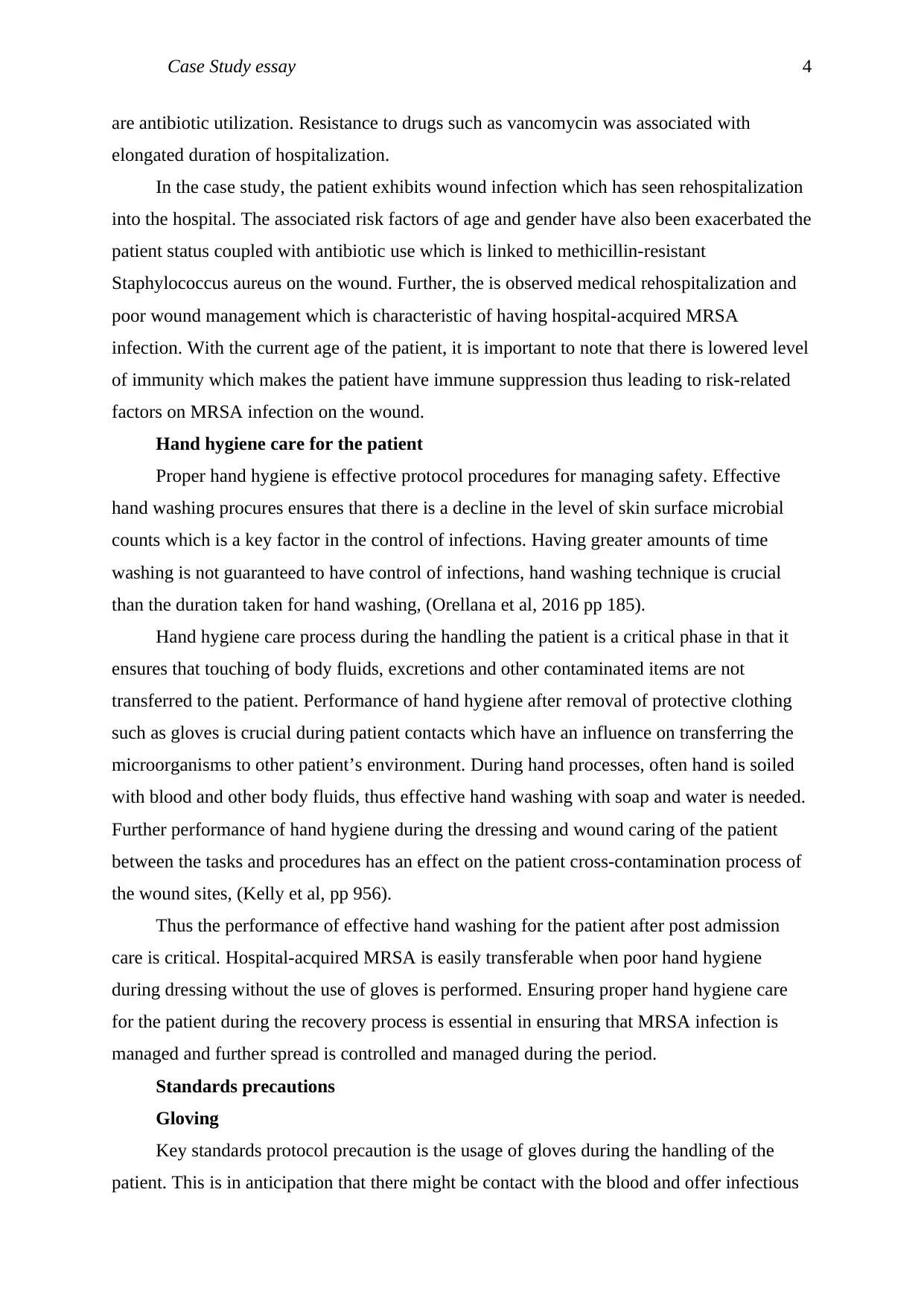
Case Study essay 4
are antibiotic utilization. Resistance to drugs such as vancomycin was associated with
elongated duration of hospitalization.
In the case study, the patient exhibits wound infection which has seen rehospitalization
into the hospital. The associated risk factors of age and gender have also been exacerbated the
patient status coupled with antibiotic use which is linked to methicillin-resistant
Staphylococcus aureus on the wound. Further, the is observed medical rehospitalization and
poor wound management which is characteristic of having hospital-acquired MRSA
infection. With the current age of the patient, it is important to note that there is lowered level
of immunity which makes the patient have immune suppression thus leading to risk-related
factors on MRSA infection on the wound.
Hand hygiene care for the patient
Proper hand hygiene is effective protocol procedures for managing safety. Effective
hand washing procures ensures that there is a decline in the level of skin surface microbial
counts which is a key factor in the control of infections. Having greater amounts of time
washing is not guaranteed to have control of infections, hand washing technique is crucial
than the duration taken for hand washing, (Orellana et al, 2016 pp 185).
Hand hygiene care process during the handling the patient is a critical phase in that it
ensures that touching of body fluids, excretions and other contaminated items are not
transferred to the patient. Performance of hand hygiene after removal of protective clothing
such as gloves is crucial during patient contacts which have an influence on transferring the
microorganisms to other patient’s environment. During hand processes, often hand is soiled
with blood and other body fluids, thus effective hand washing with soap and water is needed.
Further performance of hand hygiene during the dressing and wound caring of the patient
between the tasks and procedures has an effect on the patient cross-contamination process of
the wound sites, (Kelly et al, pp 956).
Thus the performance of effective hand washing for the patient after post admission
care is critical. Hospital-acquired MRSA is easily transferable when poor hand hygiene
during dressing without the use of gloves is performed. Ensuring proper hand hygiene care
for the patient during the recovery process is essential in ensuring that MRSA infection is
managed and further spread is controlled and managed during the period.
Standards precautions
Gloving
Key standards protocol precaution is the usage of gloves during the handling of the
patient. This is in anticipation that there might be contact with the blood and offer infectious
are antibiotic utilization. Resistance to drugs such as vancomycin was associated with
elongated duration of hospitalization.
In the case study, the patient exhibits wound infection which has seen rehospitalization
into the hospital. The associated risk factors of age and gender have also been exacerbated the
patient status coupled with antibiotic use which is linked to methicillin-resistant
Staphylococcus aureus on the wound. Further, the is observed medical rehospitalization and
poor wound management which is characteristic of having hospital-acquired MRSA
infection. With the current age of the patient, it is important to note that there is lowered level
of immunity which makes the patient have immune suppression thus leading to risk-related
factors on MRSA infection on the wound.
Hand hygiene care for the patient
Proper hand hygiene is effective protocol procedures for managing safety. Effective
hand washing procures ensures that there is a decline in the level of skin surface microbial
counts which is a key factor in the control of infections. Having greater amounts of time
washing is not guaranteed to have control of infections, hand washing technique is crucial
than the duration taken for hand washing, (Orellana et al, 2016 pp 185).
Hand hygiene care process during the handling the patient is a critical phase in that it
ensures that touching of body fluids, excretions and other contaminated items are not
transferred to the patient. Performance of hand hygiene after removal of protective clothing
such as gloves is crucial during patient contacts which have an influence on transferring the
microorganisms to other patient’s environment. During hand processes, often hand is soiled
with blood and other body fluids, thus effective hand washing with soap and water is needed.
Further performance of hand hygiene during the dressing and wound caring of the patient
between the tasks and procedures has an effect on the patient cross-contamination process of
the wound sites, (Kelly et al, pp 956).
Thus the performance of effective hand washing for the patient after post admission
care is critical. Hospital-acquired MRSA is easily transferable when poor hand hygiene
during dressing without the use of gloves is performed. Ensuring proper hand hygiene care
for the patient during the recovery process is essential in ensuring that MRSA infection is
managed and further spread is controlled and managed during the period.
Standards precautions
Gloving
Key standards protocol precaution is the usage of gloves during the handling of the
patient. This is in anticipation that there might be contact with the blood and offer infectious
Paraphrase This Document
Need a fresh take? Get an instant paraphrase of this document with our AI Paraphraser
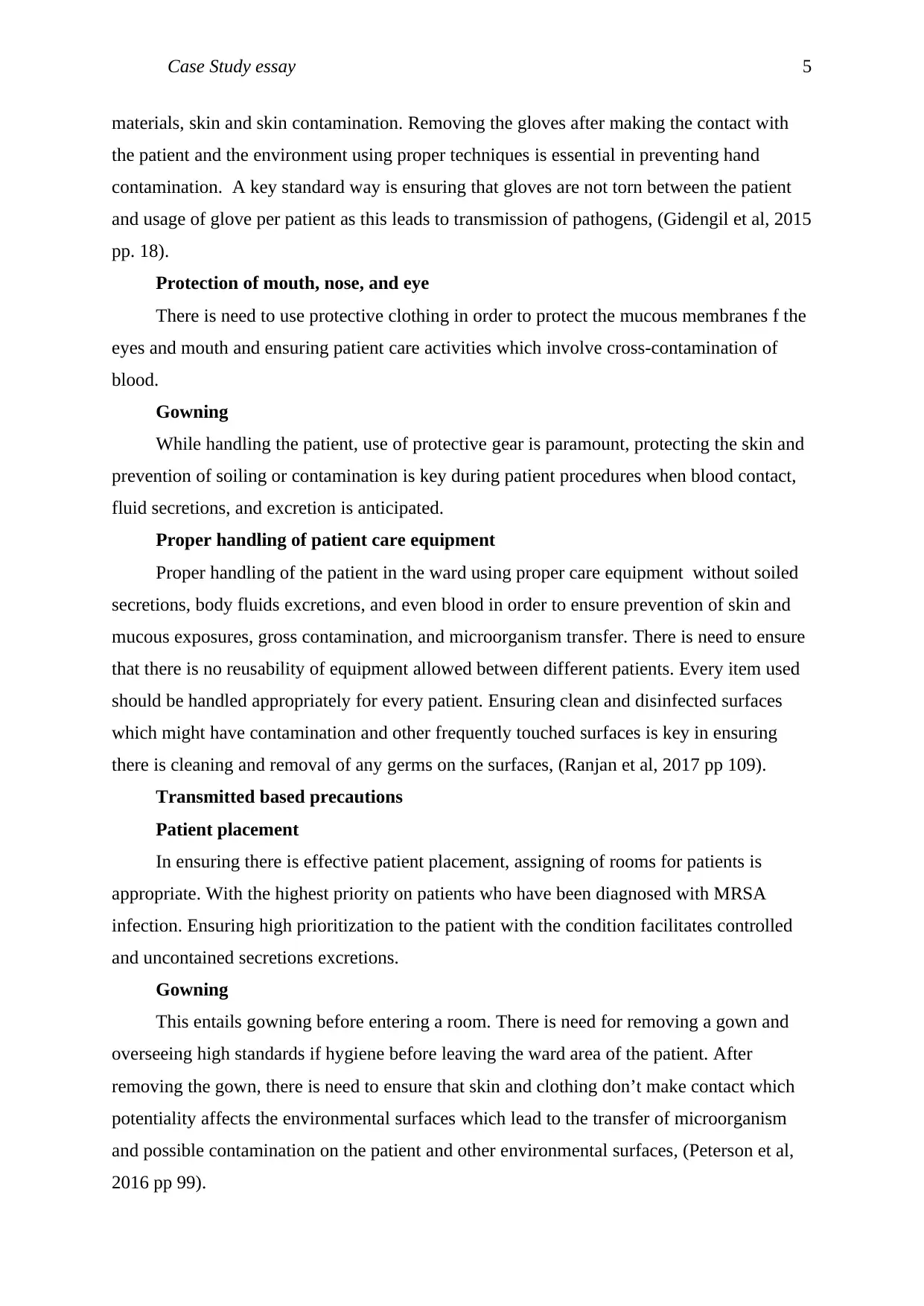
Case Study essay 5
materials, skin and skin contamination. Removing the gloves after making the contact with
the patient and the environment using proper techniques is essential in preventing hand
contamination. A key standard way is ensuring that gloves are not torn between the patient
and usage of glove per patient as this leads to transmission of pathogens, (Gidengil et al, 2015
pp. 18).
Protection of mouth, nose, and eye
There is need to use protective clothing in order to protect the mucous membranes f the
eyes and mouth and ensuring patient care activities which involve cross-contamination of
blood.
Gowning
While handling the patient, use of protective gear is paramount, protecting the skin and
prevention of soiling or contamination is key during patient procedures when blood contact,
fluid secretions, and excretion is anticipated.
Proper handling of patient care equipment
Proper handling of the patient in the ward using proper care equipment without soiled
secretions, body fluids excretions, and even blood in order to ensure prevention of skin and
mucous exposures, gross contamination, and microorganism transfer. There is need to ensure
that there is no reusability of equipment allowed between different patients. Every item used
should be handled appropriately for every patient. Ensuring clean and disinfected surfaces
which might have contamination and other frequently touched surfaces is key in ensuring
there is cleaning and removal of any germs on the surfaces, (Ranjan et al, 2017 pp 109).
Transmitted based precautions
Patient placement
In ensuring there is effective patient placement, assigning of rooms for patients is
appropriate. With the highest priority on patients who have been diagnosed with MRSA
infection. Ensuring high prioritization to the patient with the condition facilitates controlled
and uncontained secretions excretions.
Gowning
This entails gowning before entering a room. There is need for removing a gown and
overseeing high standards if hygiene before leaving the ward area of the patient. After
removing the gown, there is need to ensure that skin and clothing don’t make contact which
potentiality affects the environmental surfaces which lead to the transfer of microorganism
and possible contamination on the patient and other environmental surfaces, (Peterson et al,
2016 pp 99).
materials, skin and skin contamination. Removing the gloves after making the contact with
the patient and the environment using proper techniques is essential in preventing hand
contamination. A key standard way is ensuring that gloves are not torn between the patient
and usage of glove per patient as this leads to transmission of pathogens, (Gidengil et al, 2015
pp. 18).
Protection of mouth, nose, and eye
There is need to use protective clothing in order to protect the mucous membranes f the
eyes and mouth and ensuring patient care activities which involve cross-contamination of
blood.
Gowning
While handling the patient, use of protective gear is paramount, protecting the skin and
prevention of soiling or contamination is key during patient procedures when blood contact,
fluid secretions, and excretion is anticipated.
Proper handling of patient care equipment
Proper handling of the patient in the ward using proper care equipment without soiled
secretions, body fluids excretions, and even blood in order to ensure prevention of skin and
mucous exposures, gross contamination, and microorganism transfer. There is need to ensure
that there is no reusability of equipment allowed between different patients. Every item used
should be handled appropriately for every patient. Ensuring clean and disinfected surfaces
which might have contamination and other frequently touched surfaces is key in ensuring
there is cleaning and removal of any germs on the surfaces, (Ranjan et al, 2017 pp 109).
Transmitted based precautions
Patient placement
In ensuring there is effective patient placement, assigning of rooms for patients is
appropriate. With the highest priority on patients who have been diagnosed with MRSA
infection. Ensuring high prioritization to the patient with the condition facilitates controlled
and uncontained secretions excretions.
Gowning
This entails gowning before entering a room. There is need for removing a gown and
overseeing high standards if hygiene before leaving the ward area of the patient. After
removing the gown, there is need to ensure that skin and clothing don’t make contact which
potentiality affects the environmental surfaces which lead to the transfer of microorganism
and possible contamination on the patient and other environmental surfaces, (Peterson et al,
2016 pp 99).
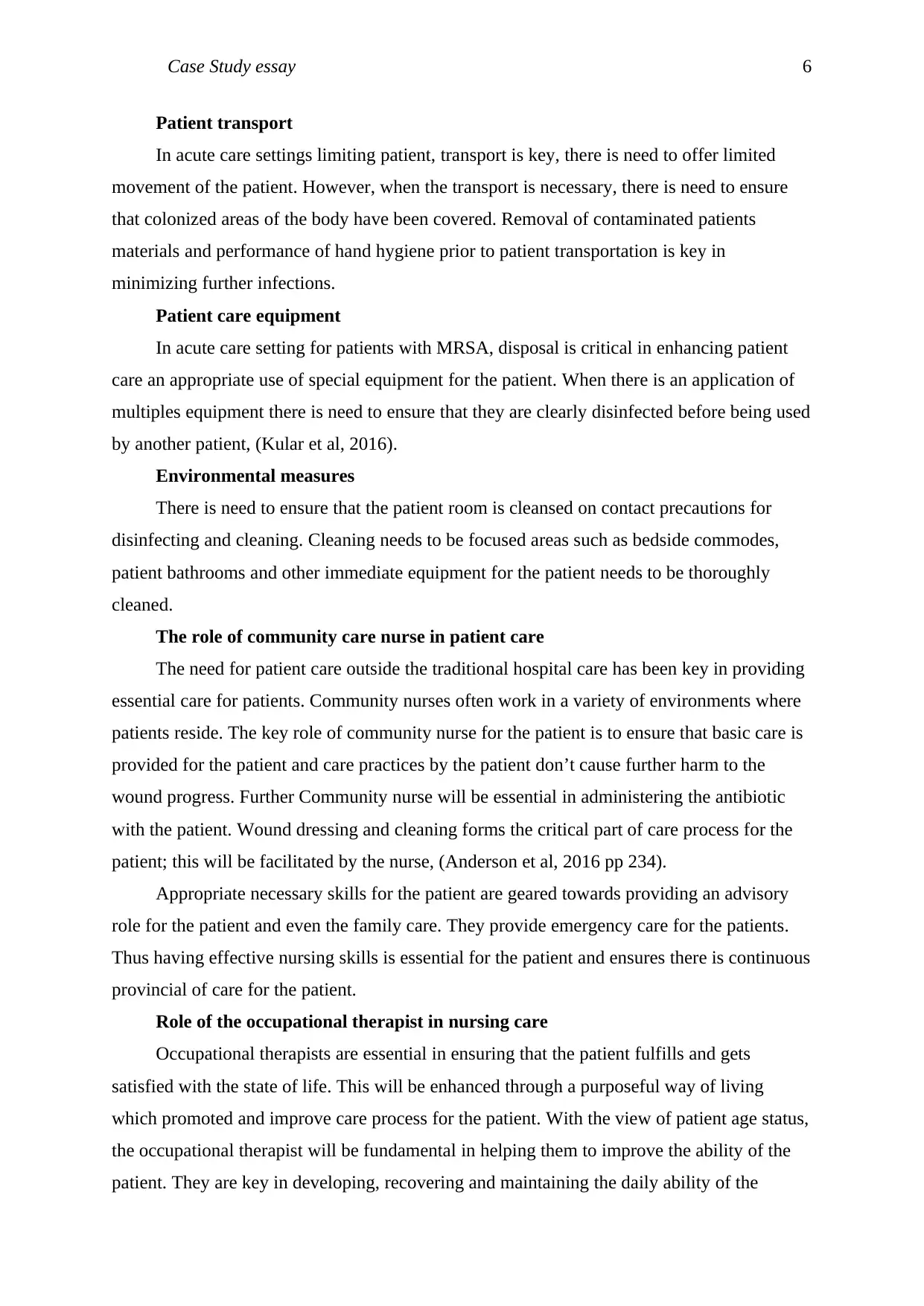
Case Study essay 6
Patient transport
In acute care settings limiting patient, transport is key, there is need to offer limited
movement of the patient. However, when the transport is necessary, there is need to ensure
that colonized areas of the body have been covered. Removal of contaminated patients
materials and performance of hand hygiene prior to patient transportation is key in
minimizing further infections.
Patient care equipment
In acute care setting for patients with MRSA, disposal is critical in enhancing patient
care an appropriate use of special equipment for the patient. When there is an application of
multiples equipment there is need to ensure that they are clearly disinfected before being used
by another patient, (Kular et al, 2016).
Environmental measures
There is need to ensure that the patient room is cleansed on contact precautions for
disinfecting and cleaning. Cleaning needs to be focused areas such as bedside commodes,
patient bathrooms and other immediate equipment for the patient needs to be thoroughly
cleaned.
The role of community care nurse in patient care
The need for patient care outside the traditional hospital care has been key in providing
essential care for patients. Community nurses often work in a variety of environments where
patients reside. The key role of community nurse for the patient is to ensure that basic care is
provided for the patient and care practices by the patient don’t cause further harm to the
wound progress. Further Community nurse will be essential in administering the antibiotic
with the patient. Wound dressing and cleaning forms the critical part of care process for the
patient; this will be facilitated by the nurse, (Anderson et al, 2016 pp 234).
Appropriate necessary skills for the patient are geared towards providing an advisory
role for the patient and even the family care. They provide emergency care for the patients.
Thus having effective nursing skills is essential for the patient and ensures there is continuous
provincial of care for the patient.
Role of the occupational therapist in nursing care
Occupational therapists are essential in ensuring that the patient fulfills and gets
satisfied with the state of life. This will be enhanced through a purposeful way of living
which promoted and improve care process for the patient. With the view of patient age status,
the occupational therapist will be fundamental in helping them to improve the ability of the
patient. They are key in developing, recovering and maintaining the daily ability of the
Patient transport
In acute care settings limiting patient, transport is key, there is need to offer limited
movement of the patient. However, when the transport is necessary, there is need to ensure
that colonized areas of the body have been covered. Removal of contaminated patients
materials and performance of hand hygiene prior to patient transportation is key in
minimizing further infections.
Patient care equipment
In acute care setting for patients with MRSA, disposal is critical in enhancing patient
care an appropriate use of special equipment for the patient. When there is an application of
multiples equipment there is need to ensure that they are clearly disinfected before being used
by another patient, (Kular et al, 2016).
Environmental measures
There is need to ensure that the patient room is cleansed on contact precautions for
disinfecting and cleaning. Cleaning needs to be focused areas such as bedside commodes,
patient bathrooms and other immediate equipment for the patient needs to be thoroughly
cleaned.
The role of community care nurse in patient care
The need for patient care outside the traditional hospital care has been key in providing
essential care for patients. Community nurses often work in a variety of environments where
patients reside. The key role of community nurse for the patient is to ensure that basic care is
provided for the patient and care practices by the patient don’t cause further harm to the
wound progress. Further Community nurse will be essential in administering the antibiotic
with the patient. Wound dressing and cleaning forms the critical part of care process for the
patient; this will be facilitated by the nurse, (Anderson et al, 2016 pp 234).
Appropriate necessary skills for the patient are geared towards providing an advisory
role for the patient and even the family care. They provide emergency care for the patients.
Thus having effective nursing skills is essential for the patient and ensures there is continuous
provincial of care for the patient.
Role of the occupational therapist in nursing care
Occupational therapists are essential in ensuring that the patient fulfills and gets
satisfied with the state of life. This will be enhanced through a purposeful way of living
which promoted and improve care process for the patient. With the view of patient age status,
the occupational therapist will be fundamental in helping them to improve the ability of the
patient. They are key in developing, recovering and maintaining the daily ability of the
⊘ This is a preview!⊘
Do you want full access?
Subscribe today to unlock all pages.

Trusted by 1+ million students worldwide
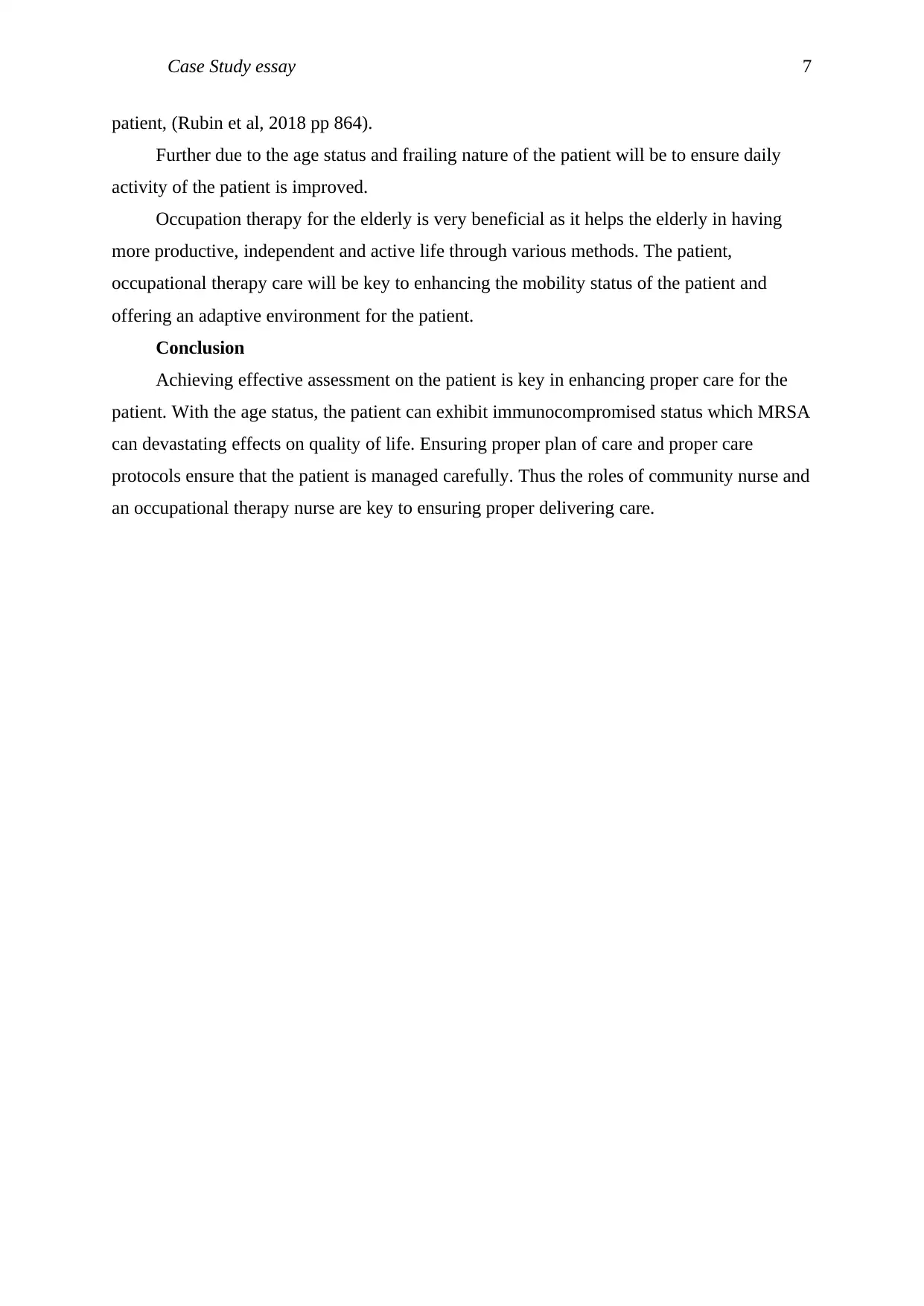
Case Study essay 7
patient, (Rubin et al, 2018 pp 864).
Further due to the age status and frailing nature of the patient will be to ensure daily
activity of the patient is improved.
Occupation therapy for the elderly is very beneficial as it helps the elderly in having
more productive, independent and active life through various methods. The patient,
occupational therapy care will be key to enhancing the mobility status of the patient and
offering an adaptive environment for the patient.
Conclusion
Achieving effective assessment on the patient is key in enhancing proper care for the
patient. With the age status, the patient can exhibit immunocompromised status which MRSA
can devastating effects on quality of life. Ensuring proper plan of care and proper care
protocols ensure that the patient is managed carefully. Thus the roles of community nurse and
an occupational therapy nurse are key to ensuring proper delivering care.
patient, (Rubin et al, 2018 pp 864).
Further due to the age status and frailing nature of the patient will be to ensure daily
activity of the patient is improved.
Occupation therapy for the elderly is very beneficial as it helps the elderly in having
more productive, independent and active life through various methods. The patient,
occupational therapy care will be key to enhancing the mobility status of the patient and
offering an adaptive environment for the patient.
Conclusion
Achieving effective assessment on the patient is key in enhancing proper care for the
patient. With the age status, the patient can exhibit immunocompromised status which MRSA
can devastating effects on quality of life. Ensuring proper plan of care and proper care
protocols ensure that the patient is managed carefully. Thus the roles of community nurse and
an occupational therapy nurse are key to ensuring proper delivering care.
Paraphrase This Document
Need a fresh take? Get an instant paraphrase of this document with our AI Paraphraser
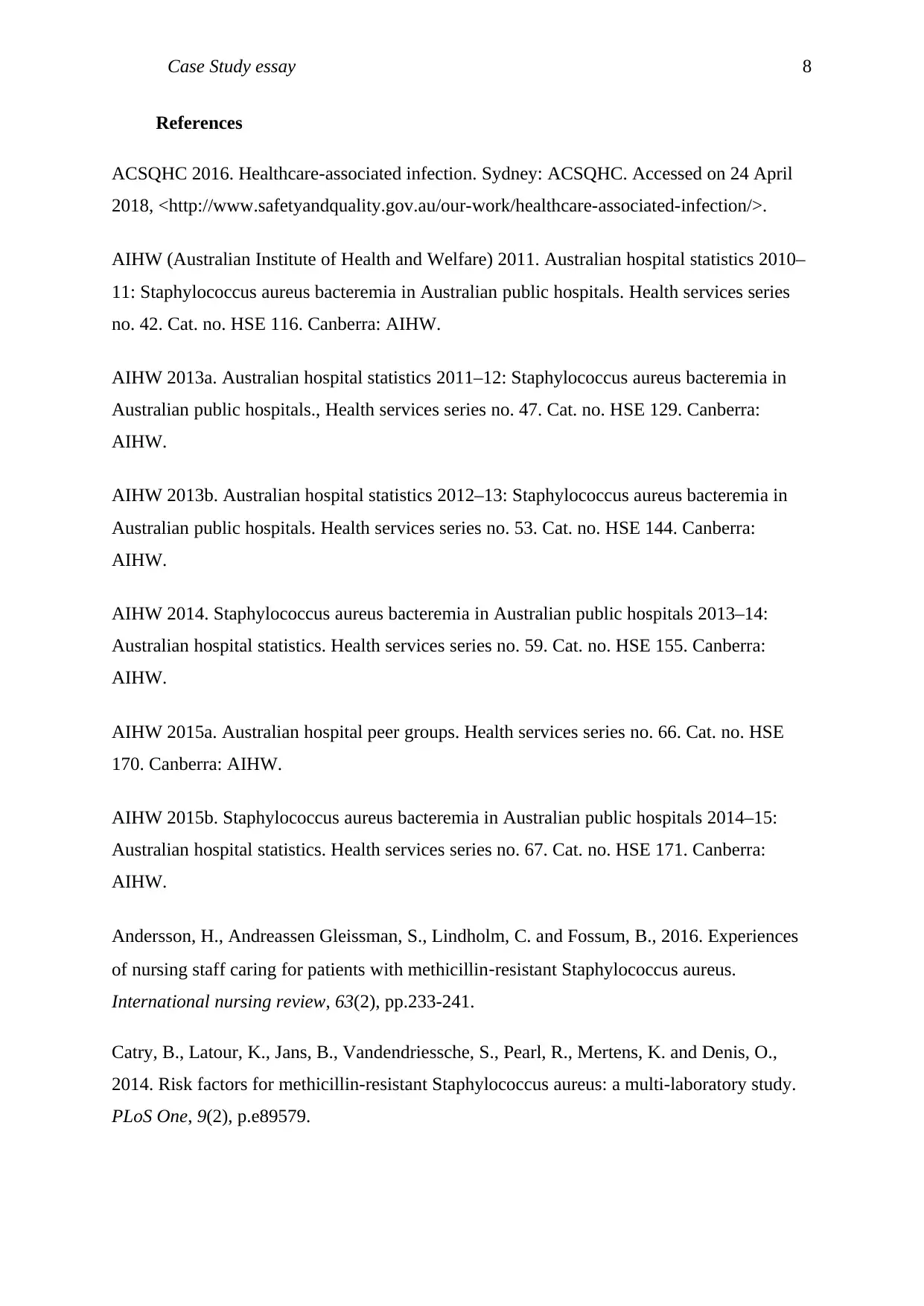
Case Study essay 8
References
ACSQHC 2016. Healthcare-associated infection. Sydney: ACSQHC. Accessed on 24 April
2018, <http://www.safetyandquality.gov.au/our-work/healthcare-associated-infection/>.
AIHW (Australian Institute of Health and Welfare) 2011. Australian hospital statistics 2010–
11: Staphylococcus aureus bacteremia in Australian public hospitals. Health services series
no. 42. Cat. no. HSE 116. Canberra: AIHW.
AIHW 2013a. Australian hospital statistics 2011–12: Staphylococcus aureus bacteremia in
Australian public hospitals., Health services series no. 47. Cat. no. HSE 129. Canberra:
AIHW.
AIHW 2013b. Australian hospital statistics 2012–13: Staphylococcus aureus bacteremia in
Australian public hospitals. Health services series no. 53. Cat. no. HSE 144. Canberra:
AIHW.
AIHW 2014. Staphylococcus aureus bacteremia in Australian public hospitals 2013–14:
Australian hospital statistics. Health services series no. 59. Cat. no. HSE 155. Canberra:
AIHW.
AIHW 2015a. Australian hospital peer groups. Health services series no. 66. Cat. no. HSE
170. Canberra: AIHW.
AIHW 2015b. Staphylococcus aureus bacteremia in Australian public hospitals 2014–15:
Australian hospital statistics. Health services series no. 67. Cat. no. HSE 171. Canberra:
AIHW.
Andersson, H., Andreassen Gleissman, S., Lindholm, C. and Fossum, B., 2016. Experiences
of nursing staff caring for patients with methicillin‐resistant Staphylococcus aureus.
International nursing review, 63(2), pp.233-241.
Catry, B., Latour, K., Jans, B., Vandendriessche, S., Pearl, R., Mertens, K. and Denis, O.,
2014. Risk factors for methicillin-resistant Staphylococcus aureus: a multi-laboratory study.
PLoS One, 9(2), p.e89579.
References
ACSQHC 2016. Healthcare-associated infection. Sydney: ACSQHC. Accessed on 24 April
2018, <http://www.safetyandquality.gov.au/our-work/healthcare-associated-infection/>.
AIHW (Australian Institute of Health and Welfare) 2011. Australian hospital statistics 2010–
11: Staphylococcus aureus bacteremia in Australian public hospitals. Health services series
no. 42. Cat. no. HSE 116. Canberra: AIHW.
AIHW 2013a. Australian hospital statistics 2011–12: Staphylococcus aureus bacteremia in
Australian public hospitals., Health services series no. 47. Cat. no. HSE 129. Canberra:
AIHW.
AIHW 2013b. Australian hospital statistics 2012–13: Staphylococcus aureus bacteremia in
Australian public hospitals. Health services series no. 53. Cat. no. HSE 144. Canberra:
AIHW.
AIHW 2014. Staphylococcus aureus bacteremia in Australian public hospitals 2013–14:
Australian hospital statistics. Health services series no. 59. Cat. no. HSE 155. Canberra:
AIHW.
AIHW 2015a. Australian hospital peer groups. Health services series no. 66. Cat. no. HSE
170. Canberra: AIHW.
AIHW 2015b. Staphylococcus aureus bacteremia in Australian public hospitals 2014–15:
Australian hospital statistics. Health services series no. 67. Cat. no. HSE 171. Canberra:
AIHW.
Andersson, H., Andreassen Gleissman, S., Lindholm, C. and Fossum, B., 2016. Experiences
of nursing staff caring for patients with methicillin‐resistant Staphylococcus aureus.
International nursing review, 63(2), pp.233-241.
Catry, B., Latour, K., Jans, B., Vandendriessche, S., Pearl, R., Mertens, K. and Denis, O.,
2014. Risk factors for methicillin-resistant Staphylococcus aureus: a multi-laboratory study.
PLoS One, 9(2), p.e89579.
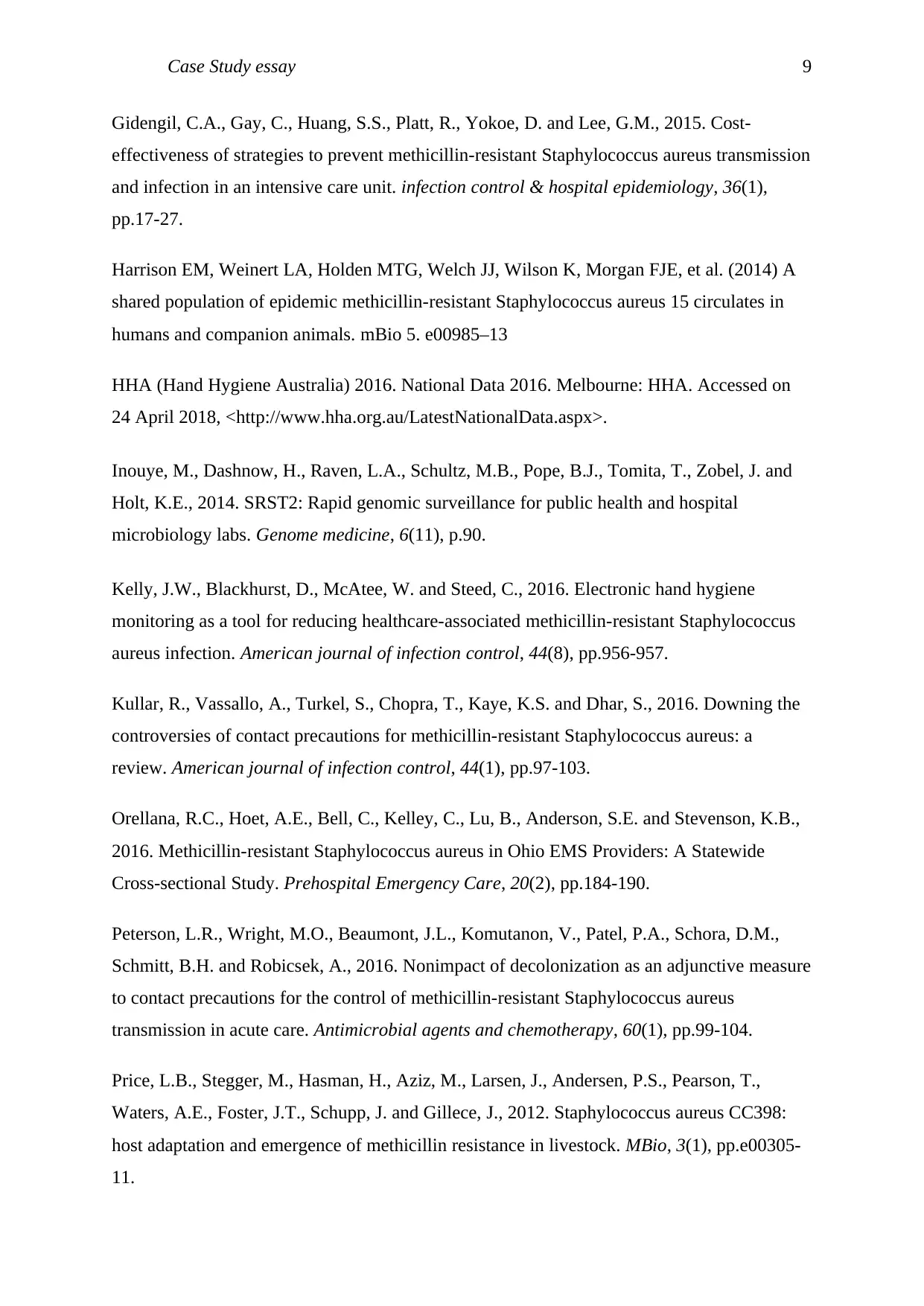
Case Study essay 9
Gidengil, C.A., Gay, C., Huang, S.S., Platt, R., Yokoe, D. and Lee, G.M., 2015. Cost-
effectiveness of strategies to prevent methicillin-resistant Staphylococcus aureus transmission
and infection in an intensive care unit. infection control & hospital epidemiology, 36(1),
pp.17-27.
Harrison EM, Weinert LA, Holden MTG, Welch JJ, Wilson K, Morgan FJE, et al. (2014) A
shared population of epidemic methicillin-resistant Staphylococcus aureus 15 circulates in
humans and companion animals. mBio 5. e00985–13
HHA (Hand Hygiene Australia) 2016. National Data 2016. Melbourne: HHA. Accessed on
24 April 2018, <http://www.hha.org.au/LatestNationalData.aspx>.
Inouye, M., Dashnow, H., Raven, L.A., Schultz, M.B., Pope, B.J., Tomita, T., Zobel, J. and
Holt, K.E., 2014. SRST2: Rapid genomic surveillance for public health and hospital
microbiology labs. Genome medicine, 6(11), p.90.
Kelly, J.W., Blackhurst, D., McAtee, W. and Steed, C., 2016. Electronic hand hygiene
monitoring as a tool for reducing healthcare-associated methicillin-resistant Staphylococcus
aureus infection. American journal of infection control, 44(8), pp.956-957.
Kullar, R., Vassallo, A., Turkel, S., Chopra, T., Kaye, K.S. and Dhar, S., 2016. Downing the
controversies of contact precautions for methicillin-resistant Staphylococcus aureus: a
review. American journal of infection control, 44(1), pp.97-103.
Orellana, R.C., Hoet, A.E., Bell, C., Kelley, C., Lu, B., Anderson, S.E. and Stevenson, K.B.,
2016. Methicillin-resistant Staphylococcus aureus in Ohio EMS Providers: A Statewide
Cross-sectional Study. Prehospital Emergency Care, 20(2), pp.184-190.
Peterson, L.R., Wright, M.O., Beaumont, J.L., Komutanon, V., Patel, P.A., Schora, D.M.,
Schmitt, B.H. and Robicsek, A., 2016. Nonimpact of decolonization as an adjunctive measure
to contact precautions for the control of methicillin-resistant Staphylococcus aureus
transmission in acute care. Antimicrobial agents and chemotherapy, 60(1), pp.99-104.
Price, L.B., Stegger, M., Hasman, H., Aziz, M., Larsen, J., Andersen, P.S., Pearson, T.,
Waters, A.E., Foster, J.T., Schupp, J. and Gillece, J., 2012. Staphylococcus aureus CC398:
host adaptation and emergence of methicillin resistance in livestock. MBio, 3(1), pp.e00305-
11.
Gidengil, C.A., Gay, C., Huang, S.S., Platt, R., Yokoe, D. and Lee, G.M., 2015. Cost-
effectiveness of strategies to prevent methicillin-resistant Staphylococcus aureus transmission
and infection in an intensive care unit. infection control & hospital epidemiology, 36(1),
pp.17-27.
Harrison EM, Weinert LA, Holden MTG, Welch JJ, Wilson K, Morgan FJE, et al. (2014) A
shared population of epidemic methicillin-resistant Staphylococcus aureus 15 circulates in
humans and companion animals. mBio 5. e00985–13
HHA (Hand Hygiene Australia) 2016. National Data 2016. Melbourne: HHA. Accessed on
24 April 2018, <http://www.hha.org.au/LatestNationalData.aspx>.
Inouye, M., Dashnow, H., Raven, L.A., Schultz, M.B., Pope, B.J., Tomita, T., Zobel, J. and
Holt, K.E., 2014. SRST2: Rapid genomic surveillance for public health and hospital
microbiology labs. Genome medicine, 6(11), p.90.
Kelly, J.W., Blackhurst, D., McAtee, W. and Steed, C., 2016. Electronic hand hygiene
monitoring as a tool for reducing healthcare-associated methicillin-resistant Staphylococcus
aureus infection. American journal of infection control, 44(8), pp.956-957.
Kullar, R., Vassallo, A., Turkel, S., Chopra, T., Kaye, K.S. and Dhar, S., 2016. Downing the
controversies of contact precautions for methicillin-resistant Staphylococcus aureus: a
review. American journal of infection control, 44(1), pp.97-103.
Orellana, R.C., Hoet, A.E., Bell, C., Kelley, C., Lu, B., Anderson, S.E. and Stevenson, K.B.,
2016. Methicillin-resistant Staphylococcus aureus in Ohio EMS Providers: A Statewide
Cross-sectional Study. Prehospital Emergency Care, 20(2), pp.184-190.
Peterson, L.R., Wright, M.O., Beaumont, J.L., Komutanon, V., Patel, P.A., Schora, D.M.,
Schmitt, B.H. and Robicsek, A., 2016. Nonimpact of decolonization as an adjunctive measure
to contact precautions for the control of methicillin-resistant Staphylococcus aureus
transmission in acute care. Antimicrobial agents and chemotherapy, 60(1), pp.99-104.
Price, L.B., Stegger, M., Hasman, H., Aziz, M., Larsen, J., Andersen, P.S., Pearson, T.,
Waters, A.E., Foster, J.T., Schupp, J. and Gillece, J., 2012. Staphylococcus aureus CC398:
host adaptation and emergence of methicillin resistance in livestock. MBio, 3(1), pp.e00305-
11.
⊘ This is a preview!⊘
Do you want full access?
Subscribe today to unlock all pages.

Trusted by 1+ million students worldwide
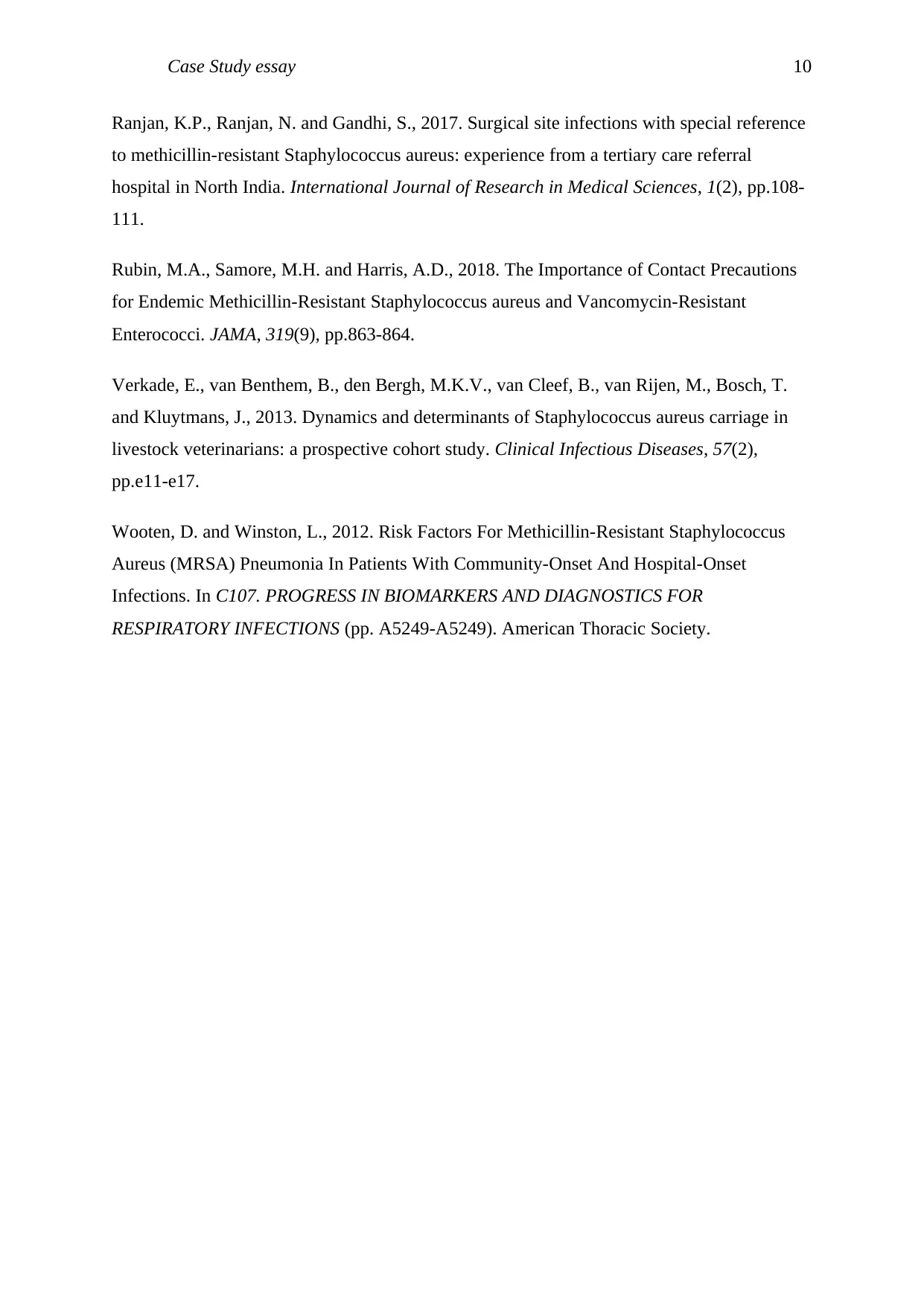
Case Study essay 10
Ranjan, K.P., Ranjan, N. and Gandhi, S., 2017. Surgical site infections with special reference
to methicillin-resistant Staphylococcus aureus: experience from a tertiary care referral
hospital in North India. International Journal of Research in Medical Sciences, 1(2), pp.108-
111.
Rubin, M.A., Samore, M.H. and Harris, A.D., 2018. The Importance of Contact Precautions
for Endemic Methicillin-Resistant Staphylococcus aureus and Vancomycin-Resistant
Enterococci. JAMA, 319(9), pp.863-864.
Verkade, E., van Benthem, B., den Bergh, M.K.V., van Cleef, B., van Rijen, M., Bosch, T.
and Kluytmans, J., 2013. Dynamics and determinants of Staphylococcus aureus carriage in
livestock veterinarians: a prospective cohort study. Clinical Infectious Diseases, 57(2),
pp.e11-e17.
Wooten, D. and Winston, L., 2012. Risk Factors For Methicillin-Resistant Staphylococcus
Aureus (MRSA) Pneumonia In Patients With Community-Onset And Hospital-Onset
Infections. In C107. PROGRESS IN BIOMARKERS AND DIAGNOSTICS FOR
RESPIRATORY INFECTIONS (pp. A5249-A5249). American Thoracic Society.
Ranjan, K.P., Ranjan, N. and Gandhi, S., 2017. Surgical site infections with special reference
to methicillin-resistant Staphylococcus aureus: experience from a tertiary care referral
hospital in North India. International Journal of Research in Medical Sciences, 1(2), pp.108-
111.
Rubin, M.A., Samore, M.H. and Harris, A.D., 2018. The Importance of Contact Precautions
for Endemic Methicillin-Resistant Staphylococcus aureus and Vancomycin-Resistant
Enterococci. JAMA, 319(9), pp.863-864.
Verkade, E., van Benthem, B., den Bergh, M.K.V., van Cleef, B., van Rijen, M., Bosch, T.
and Kluytmans, J., 2013. Dynamics and determinants of Staphylococcus aureus carriage in
livestock veterinarians: a prospective cohort study. Clinical Infectious Diseases, 57(2),
pp.e11-e17.
Wooten, D. and Winston, L., 2012. Risk Factors For Methicillin-Resistant Staphylococcus
Aureus (MRSA) Pneumonia In Patients With Community-Onset And Hospital-Onset
Infections. In C107. PROGRESS IN BIOMARKERS AND DIAGNOSTICS FOR
RESPIRATORY INFECTIONS (pp. A5249-A5249). American Thoracic Society.
1 out of 10
Related Documents
Your All-in-One AI-Powered Toolkit for Academic Success.
+13062052269
info@desklib.com
Available 24*7 on WhatsApp / Email
![[object Object]](/_next/static/media/star-bottom.7253800d.svg)
Unlock your academic potential
Copyright © 2020–2025 A2Z Services. All Rights Reserved. Developed and managed by ZUCOL.





